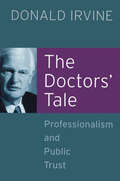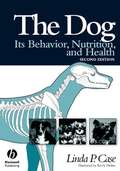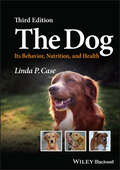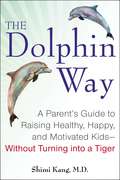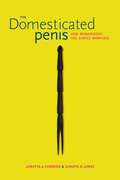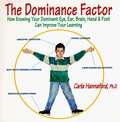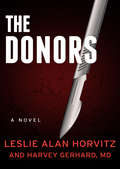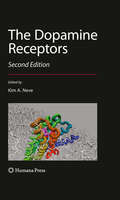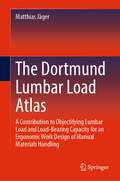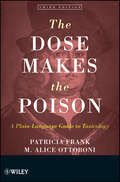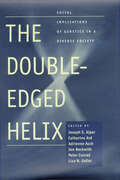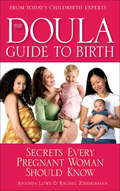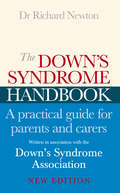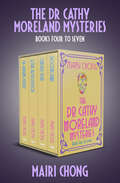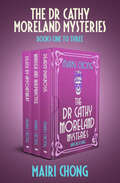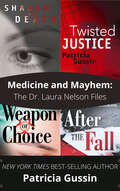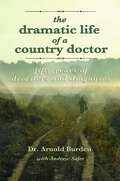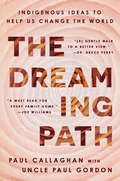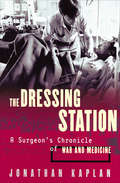- Table View
- List View
The Doctors' Tale - Professionalism and Public Trust
by Donald IrvineSir Donald Irvine asks what further changes have to be made to the culture and regulation of medicine to make it as trustworthy as the public today expects. As President of the General Medical Council between 1995 and 2002, Sir Donald helped shape the changes that followed disasters like the deaths of babies at Bristol and the murders of Dr Harold Shipman. In this frenetic period a new ethos of professionalism emerged, embodying the concept of the autonomous patient and more robust, transparent professional regulation founded on a partnership between the public and doctors. Sir Donald discusses candidly the struggles in the profession and with successive Governments over the key issues. He provides perspectives that are both startling and enlightening. He criticises the British Medical Association for its past resistance to accept the need for change, and explains why its role in the future must be radically different. He calls for specific fundamental changes to the National Health Service, and for Government to be separated from managing the provision of healthcare. And he outlines the qualities that the bodies regulating doctors in the future must have to succeed. In part a personal testimony, in part a clarion call for doctors to secure the new culture and re-establish public confidence, The Doctors' Tale is gripping and essential reading for everyone who cares about health.
The Dog: Its Behavior, Nutrition, and Health
by Linda P. CaseDogs are a part of nearly 40 percent of United States households. With this in mind, author Linda P. Case has written the definitive textbook on dogs and their care. Completely updated and revised, the second edition of The Dog covers four areas of compelling interest: the bond between dogs and humans, canine behavior, canine health and disease, and canine nutrition. Aiming to enhance the human-dog bond, author Case uses clear, understandable writing to explain selective breeding, training principles, solution to common behavior problems, diet and nutrition, and preventative health care. Case liberally uses distinctive figures and tables, current references plus suggested readings, and a thorough glossary to aid in comprehension. More in-depth that most dog books, The Dog will prove to be an indispensable tool for undergraduate companion animal courses, veterinary technician courses, and dog care/training courses. In addition, it will serve as a valuable resource for professional breeders, trainers, exhibitors, and veterinary clinicians.
The Dog: Its Behavior, Nutrition, and Health
by Linda P. CaseThe Dog In-depth coverage of canine domestication, breeding, behavior and cognition, training, health care, and nutrition Now in its third edition, The Dog remains a definitive textbook regarding dogs and their care; written in clear, accessible language, the text provides updated and expanded coverage of selective breeding, training principles, solutions to common behavior problems, diet and nutrition, and preventive health care. New sections in this edition include information about dog breeds and selective breeding practices, genetic testing programs, canine social cognition and communication, manners training and common behavior problems, popular dog sports, and new information regarding health care and disease prevention. Enhanced with distinctive figures and tables, the text provides current references, suggested readings, updated tables and references, and a thorough glossary to aid in comprehension. In The Dog, readers can expect to find detailed information about: Canine behavior, reward-based approaches to training, health care and disease prevention, new information about pet foods and nutrition, and a review of research regarding the unique social cognition of the domestic dog Breed specific diseases and their genetic testing, canine infectious viruses and atopic disease, and new vaccines and vaccination schedules Interspecies communications between dogs and humans, prevention and management of common behavior problems in dogs, and pet food selection and recommended feeding practices More detailed and comprehensive than many other dog books, The Dog is an indispensable tool for veterinarians, veterinary technicians, trainers, behaviorists, breeders, animal shelter and rescue group staff, and dog owners. Academically, The Dog is a useful textbook for second- or third-year students who have completed at least one college-level biology course.
The Dolphin Way
by Shimi KangIn this inspiring book, Harvard-trained child and adult psychiatrist and expert in human motivation Dr. Shimi Kang provides a guide to the art and science of inspiring children to develop their own internal drive and a lifelong love of learning. Drawing on the latest neuroscience and behavioral research, Dr. Kang shows why pushy "tiger parents" and permissive "jellyfish parents" actually hinder self-motivation. She proposes a powerful new parenting model: the intelligent, joyful, playful, highly social dolphin. Dolphin parents focus on maintaining balance in their children's lives to gently yet authoritatively guide them toward lasting health, happiness, and success. As the medical director for Child and Youth Mental Health community programs in Vancouver, British Columbia, Dr. Kang has witnessed firsthand the consequences of parental pressure: anxiety disorders, high stress levels, suicides, and addictions. As the mother of three children and as the daughter of immigrant parents who struggled to give their children the "best" in life--Dr. Kang's mother could not read and her father taught her math while they drove around in his taxicab--Dr. Kang argues that often the simplest "benefits" we give our children are the most valuable. By trusting our deepest intuitions about what is best for our kids, we will in turn allow them to develop key dolphin traits to enable them to thrive in an increasingly complex world: adaptability, community-mindedness, creativity, and critical thinking. Life is a journey through ever-changing waters, and dolphin parents know that the most valuable help we can give our children is to assist them in developing their own inner compass. Combining irrefutable science with unforgettable real-life stories, The Dolphin Way walks readers through Dr. Kang's four-part method for cultivating self-motivation. The book makes a powerful case that we are not forced to choose between being permissive or controlling. The third option--the option that will prepare our kids for success in a future that will require adaptability--is the dolphin way.
The Domestic and International Impacts of the 2009-H1N1 Influenza a Pandemic: Global Challenges, Global Solutions - Workshop Summary
by Institute of Medicine of the National AcademiesIn March and early April 2009, a new, swine-origin 2009-H1N1 influenza A virus emerged in Mexico and the United States. During the first few weeks of surveillance, the virus spread by human-to-human transmission worldwide to over 30 countries. On June 11, 2009, the World Health Organization (WHO) raised the worldwide pandemic alert level to Phase 6 in response to the ongoing global spread of the novel influenza A (H1N1) virus. By October 30, 2009, the H1N1 influenza A had spread to 191 countries and resulted in 5,700 fatalities. A national emergency was declared in the United States and the swine flu joined SARS and the avian flu as pandemics of the 21st century. Vaccination is currently available, but in limited supply, and with a 60 percent effectiveness rate against the virus. The story of how this new influenza virus spread out of Mexico to other parts of North America and then on to Europe, the Far East, and now Australia and the Pacific Rim countries has its origins in the global interconnectedness of travel, trade, and tourism. Given the rapid spread of the virus, the international scientific, public health, security, and policy communities had to mobilize quickly to characterize this unique virus and address its potential effects. The World Health Organization and Centers for Disease Control have played critical roles in the surveillance, detection and responses to the H1N1 virus. The Domestic and International Impacts of the 2009-H1N1 Influenza A Pandemic: Global Challenges, Global Solutions aimed to examine the evolutionary origins of the H1N1 virus and evaluate its potential public health and socioeconomic consequences, while monitoring and mitigating the impact of a fast-moving pandemic. The rapporteurs for this workshop reported on the need for increased and geographically robust global influenza vaccine production capacities; enhanced and sustained interpandemic demand for seasonal influenza vaccines; clear "triggers" for pandemic alert levels; and accelerated research collaboration on new vaccine manufacturing techniques. This book will be an essential guide for healthcare professionals, policymakers, drug manufacturers and investigators.
The Dominance Factor: How Knowing Your Dominant Eye, Ear, Brain, Hand and Foot Can Improve Your Learning
by Carla HannafordNeuroscientist and educator Dr. Carla Hannaford fascinating frontier (study) of knowledge about ... and its impact on learning and thinking at an ages. Her earlier book, Smart Moves, Why Learning Is Not All In Your Head, has been hailed for its insights into the body's role in learning. Joseph Chilton Pearce calls it "a major work of profound importance to our understanding of child development and education." In The Dominance Factor she explores an area that has long intrigued scientists and educators: the linkages between the side of the body we favor for seeing, hearing, touching, and moving and the way we think, learn, work, play, and relate to others. Your Dominance Profile is actually a key factor in shaping the way you think and act. Carla Hannaford shows why, and reveals how knowing your Profile will help you, and your children, to learn in the way that suits you best, and perform at your highest level. The Dominance Factor clearly explains methods for discovering your Profile that are so simple, non-invasive and easy to learn that even a child can do them. This is a book that parents, teachers, and all of us who need to understand what makes ourselves and others tick, will use and enjoy.
The Donors
by Leslie Alan Horvitz Harvey GerhardThe death of an actress exposes a secret network that traffics identities--and livesOn a crisp winter night, glamorous actress Maia Stevens is killed in a car accident. Alone in her car, her body burns to ash. But before long, Michael Reiss in the New York City Chief Medical Examiner's Office discovers a number of strange inconsistencies. At first he suspects foul play, but he soon discovers that the body recovered from the car didn't belong to Maia Stevens at all. If Maia didn't die in the car crash, then where is she? And who is the victim? Under pressure from the Center for Rehabilitative Medicine to keep his findings a secret, Michael begins to suspect that something sinister is at play, something larger than a single faked death. To find the truth, Michael must put his body, his life, and his identity on the line and become someone else.
The Dopamine Receptors
by Kim NeveAs sites of action for drugs used to treat schizophrenia and Parkinson's disease, dopamine receptors are among the most validated drug targets for neuropsychiatric disorders. Dopamine receptors are also drug targets or potential targets for other disorders such as substance abuse, depression, Tourette's syndrome, and attention deficit hyperactivity disorder. Updated from the successful first edition, "The Dopamine Receptors" serves as a reference work on dopamine receptors while also highlighting the areas of research that are most active today. To achieve this goal, authors have written chapters that set a broad area of research in its historical context, rather than focusing on the research output of their own laboratories.
The Dortmund Lumbar Load Atlas: A Contribution to Objectifying Lumbar Load and Load-Bearing Capacity for an Ergonomic Work Design of Manual Materials Handling
by Matthias JägerThis handbook supports the identification of inappropriate work design in manual materials handling and thus the prevention of overloading the body and of the development of health disorders. The approach at hand, The Dortmund Lumbar Load Atlas, is focussed exclusively on biomechanical aspects of loading, overload criteria and signs of overloading in the form of verifiable low-back diseases due its strikingly frequently affectedness. Manual materials handling is understood to be the holding, lifting or lowering, pulling or pushing as well as carrying of load objects and thus the application of forces mostly with one or both hands on the item handled. Due to the biomechanical similarity, special handling tasks are also addressed, such as shoveling bulk material, transporting goods via wheelbarrow and moving people manually in the care sector. The book aims to promote interest in biomechanical approaches and provides information to all persons involved in the design, evaluation and redesign of manual materials handling, e.g. ergonomists, occupational physicians, orthopaedists, employers or researchers, lecturers and students. This handbook enables analysis of manual materials handlings regarding potential lumbar overload and contains the following:a comprehensive collection of data on lumbar load in typical manual materials handling activities—a load register on interbranch activities,synopses of previously analysed biomechanically challenging occupational activities—a load register on branch-specific activities,explanations of the methodological approach to predicting moments and forces as well as their components in relation to the lumbar spine via biomechanical modelling andcriteria for the evaluation of load data with regard to potential lumbar overloading during single operations, working shifts and the entire occupational life. The new recommendations on maximum daily exposure for lifelong work for both men and women are bridging the former gap of biomechanically justified action frequency limits and now offer the possibility of a completely biomechanical path for risk assessment of manual materials handling. The book provides hence a serious contribution to the objectification of lumbar load and load-bearing capacity aiming at an ergonomic work design of manual materials handling for short- as well as long-term exposures.
The Dose Makes the Poison
by Patricia Frank M. Alice OttoboniThis new edition of a widely-read and highly-acclaimed book broadens the scope of its predecessors from a heavy focus on industrial chemicals as toxicants to include drugs, food additives, cosmetics and other types of compounds that people are exposed to daily. Also new to the 3rd edition are newer issues-of-the-day such as nanoparticulate toxicants, second hand smoke, food contamination, lead in toys, and others. As such, the book provides the basics of toxicology in easy-to-understand language as well as a fuller understanding of the daily insults to which our bodies are subjected.
The Double Edged Helix: Social Implications of Genetics in a Diverse Society
by Adrienne Asch Jon Beckwith Peter Conrad Lisa N. Geller Joseph Alper Catherine ArdThe authors address the medical and ethical implications of the new technologies, outlining potential positive and negative effects of genetic research on minorities, people with disabilities, and those of diverse sexual orientations. Presenting a wide array of perspectives, this book emphasizes the need to ensure that research into genetics does not result in discrimination against people on the basis of their DNA.
The Double-Edged Helix: Social Implications of Genetics in a Diverse Society
by Joseph S. Alper, Catherine Ard, Adrienne Asch, Jon Beckwith, Peter Conrad, and Lisa N. GellerThis bioethics anthology exploring the questions and controversies surrounding the innovations of 21st century genetics.When the Human Genome Project completed its work in the early 2000s, it was hailed as a watershed moment in the history of medicine. But not everyone felt the same optimism about where the breakthrough might lead. The Double-Edged Helix explores the impact of recent genetic discoveries on society as a whole as well as individual populations and communities. This volume outlines potential positive and negative effects of genetic research on minorities, individuals with disabilities, and those of diverse sexual orientations. Presenting a wide array of perspectives, contributors address the medical and ethical implications of newly available technologies, from prenatal genetic screenings to the so-called “gay gene” debates. They emphasize the need to ensure that genetics research does not lead to discrimination against people on the basis of their DNA.A Choice Magazine Outstanding Academic Title
The Double-Edged Helix: Social Implications of Genetics in a Diverse Society (Bioethics)
by Joseph S. Alper, Catherine Ard, Adrienne Asch, Jon Beckwith, Peter Conrad, and Lisa N. GellerSelected as an Outstanding Academic Title for 2003 from Choice MagazineThe Double-Edged Helix explores the impact of recent genetic discoveries on both different population segments and society as a whole. The authors address the medical and ethical implications of the new technologies, outlining potential positive and negative effects of genetic research on minorities, individuals with disabilities, and those of diverse sexual orientations. Presenting a wide array of perspectives, this book emphasizes the need to ensure that research into genetics research does not result in discrimination against people on the basis of their DNA.
The Doula Guide to Birth
by Rachel Zimmerman Ananda LoweHere is your guide to the fastest-growing trend in childbirth—a tradition as old as motherhood itself. Doulas,or professional labor assistants, have led thousands of expectant women through the birthing process in a way that’s safe and meaningful, and that creates the birth and postbirth experience all mothers long for. What exactly dodoulas do? How to find one that suitsyou. What are the “trade secrets” only doulas know but every woman should be aware of (even if youdon’thave a doula)? InThe Doula Guide to Birth,senior-level doula Ananda Lowe and award-winning health reporter Rachel Zimmerman have written a most comprehensive book that draws on the wisdom of these skilled experts, whose experience with doctors, midwives, nurses, and hospitals makes them invaluable advocates before, during, and after birth. * Labor techniques anyone can use * Pain medication: do you, don’t you—and when? * What dads and loved ones need and can do best * When should youreallygo to the hospital in labor? * How to prepare for unexpected medical procedures, including cesareans and epidural * Postpartum—what it’s really like * A clip-out chart of labor techniques, birth plan worksheets, and much more Combining science, wit, warmth, and support, as well as the inspirational stories of dozens of mothers and their partners, you’ll find the “doula viewpoint” on every major pregnancy and delivery issue, making this one of the most important childbirth books you’ll ever read and recommend.
The Doula Guide to Birth: Secrets Every Pregnant Woman Should Know
by Rachel Zimmerman Ananda LoweHere is your guide to the fastest-growing trend in childbirth—a tradition as old as motherhood itself. Doulas, or professional labor assistants, have led thousands of expectant women through the birthing process in a way that’s safe and meaningful, and that creates the birth and postbirth experience all mothers long for.What exactly do doulas do?How to find one that suits you.What are the “trade secrets” only doulas know but every woman should be aware of (even if you don’t have a doula)?In The Doula Guide to Birth, senior-level doula Ananda Lowe and award-winning health reporter Rachel Zimmerman have written a most comprehensive book that draws on the wisdom of these skilled experts, whose experience with doctors, midwives, nurses, and hospitals makes them invaluable advocates before, during, and after birth. * Labor techniques anyone can use* Pain medication: do you, don’t you—and when?* What dads and loved ones need and can do best* When should you really go to the hospital in labor?* How to prepare for unexpected medical procedures, including cesareans and epidural* Postpartum—what it’s really like * A clip-out chart of labor techniques, birth plan worksheets, and much more Combining science, wit, warmth, and support, as well as the inspirational stories of dozens of mothers and their partners, you’ll find the “doula viewpoint” on every major pregnancy and delivery issue, making this one of the most important childbirth books you’ll ever read and recommend.From the Trade Paperback edition.
The Down's Syndrome Handbook: The Practical Handbook for Parents and Carers
by Downs Syndrome Association Dr Richard NewtonCombining medical knowledge with sympathetic common sense, this completely updated comprehensive handbook offers help and advice to all parents and carers of children with Down's syndrome, and shows them how to help their children flourish and reach their full potential. Written in association with the Down's Syndrome Association, this book goes beyond the average introduction to Down's syndrome and addresses the questions, practical or otherwise, that parents will often find themselves asking, and also offers information and advice on a wide variety of related issues, including:--current medical knowledge about the condition--advice on the special care of babies and young children--education and training--emotional and sexual development--integration into society
The Dr Cathy Moreland Mysteries Boxset Books Four to Seven: Shooting Pains, Clinically Dead, Lethal Resuscitation, and The Vanishing Patient (The Dr. Cathy Moreland Mysteries)
by Mairi ChongFour novels in one volume, featuring a British doctor who investigates symptoms and suspects with equal dedication . . . This collection of crime thrillers stars Dr Cathy Moreland, who manages not only her own practice and her bipolar disorder, but also investigations into murder, and includes:Shooting Pains When a patient visits Cathy with a disturbing story of marital tension and a bruise on her arm, she&’s understandably concerned. But Fiona, despite confiding her fear of her husband, refuses further help. After Fiona&’s husband asks Cathy to sign his gun licence form days later, and then someone is killed with the gun, Cathy must sort through her suspicions and find out what&’s been happening behind closed doors.Clinically Dead During a condolence call to medical secretary Sara Wiseman, Cathy finds it odd that Sara seems more upset about the recent suspicious death of her boss at the hospital than about the loss of her own mother to Alzheimer&’s. But she&’s far more alarmed when Sara&’s husband says he suspects Sara was having an affair with the dead doctor—and fears that was the least of her transgressions . . .Lethal Resuscitation A medical conference becomes a murder scene when Cathy checks in at a country hotel for an advanced life support course—and the equipment meant for saving lives is instead used to kill a bad-tempered doctor.The Vanishing Patient Cathy is taken aback when an irate patient claims his ailing wife has been kidnapped by one of her colleagues using a false name. Is someone impersonating a doctor, or is Adam Steer delusional? But the more she looks into the bizarre story, the more she starts doubting her own sanity. Can she make sense of the events around her before everything spirals out of control?
The Dr Cathy Moreland Mysteries Boxset Books One to Seven: Death by Appointment, Murder & Malpractice, Deadly Diagnosis, Shooting Pains, Clinically Dead, Lethal Resuscitation, and The Vanishing Patient (The Dr. Cathy Moreland Mysteries)
by Mairi ChongSeven novels of medicine, detection, and unnatural death in the series acclaimed for its &“great characters&” (Peter Boon, author of Who Killed Miss Finch?). Cathy Moreland is skilled at both diagnosis and detection. Living in the British countryside, she must manage her own mental health while treating a constant flow of patients and solving medical mysteries. This collection includes the first seven novels in the popular series, filled with compelling tales following a dedicated doctor who strives to bring relief to the sick—and justice to the dead . . .Includes:Death by Appointment * Murder & Malpractice * Deadly Diagnosis * Shooting Pains * Clinically Dead * Lethal Resuscitation * The Vanishing Patient
The Dr. Cathy Moreland Mysteries Books One to Three: Death by Appointment, Murder & Malpractice, Deadly Diagnosis (The Dr. Cathy Moreland Mysteries)
by Mairi ChongThe first three novels in the series, featuring a physician in the British countryside who knows all too well that death isn&’t always from natural causes . . . This three-in-one murder mystery collection, written by a former practicing physician praised for her &“great characters&” (Peter Boon, author of Who Killed Miss Finch?), includes:Death by Appointment Dr. Cathy Moreland needs time to heal, having recently been diagnosed with bipolar disorder while struggling with a painkiller habit. A village on Scotland&’s coast promises respite, but after Cathy attempts to get an opiate prescription, things don&’t go well—and when she discovers the body of a fellow doctor, her sanctuary is shattered.Murder & Malpractice Returning to work after battling mental health challenges, Dr. Cathy Moreland finds her surgery in the British countryside simmering, as usual, with tensions. One doctor struggles to keep up with the changes in the medical field; another, ambitious and aggressive, is romantically entangled with a nurse. The newest arrival, a pharmacist, seems very competent—but his behaviour is mysterious. When one of them dies after drinking a cup of coffee, the practice is thrown into chaos. Circumstances seem to point toward one partner—but Cathy intends to examine the evidence more closely . . .Deadly Diagnosis As Betty Scott is dying, she warns Dr. Cathy Moreland that danger lurks at the charity shop where she volunteers. But the only clue she provides is a reference to the now-derelict psychiatric hospital called Fernibanks. Then Betty is found dead—but not from natural causes—and Cathy is compelled to investigate . . .
The Dr. Laura Nelson Collection: A Medical Thriller Series (The Laura Nelson Series, Books 1-4)
by Patricia GussinThis four book collection follows Laura Nelson from her days as a medical student in Detroit during the 1967 riots through her assent to the position of Chief of Surgery in Tampa. Tragically, at the peak of her professional success, a fall on the ice and a devastating hand injury ends her surgical career. But Laura proves resilient and lands the top research job in a large pharmaceutical company. Seven years in Laura’s life separate each of the four novels in the collection. Laura’s personal life evolves just as do the threats—initiated in the dark days of Detroit—that have haunted her along the way.
The Dramatic Life of a Country Doctor: Fifty Years of Disasters and Diagnoses
by Arnold Burden Andrew SaferA Canadian physician reflects on a lifetime of helping others, including during World War II and two deadly mining disasters.Dr. Arnold Burden&’s career began unintentionally when he performed his first surgery in the woods following a hunting accident at age fourteen. As a twenty-year-old hospital clerk, he handed battle casualties after D-Day in France and Germany. His early years as a doctor began in rural Prince Edward Island, where he served in the combined role of doctor and coroner. Back home in Springhill, Nova Scotia, Dr. Burden was the first medic to enter the mines after the deadly No. 4 mine explosion in 1956 and the No. 2 mine bump, the most severe bump ever recorded in North America, in 1958. In both cases he risked his life alongside the underground rescue teams to bring the gassed and trapped miners to the surface. In this new edition Dr. Burden gives his account of an active life and of a man dedicated to his patients; a man full of common-sense and interesting stories, who writes candidly of his dealing with patients, unusual cases, and brave efforts made under difficult conditions. As the author states: &“The real satisfaction in life has come from helping people.&”
The Dramatic Life of a Country Doctor: Fifty Years of Disasters and Diagnoses
by Arnold Burden Andrew SaferA Canadian physician reflects on a lifetime of helping others, including during World War II and two deadly mining disasters.Dr. Arnold Burden&’s career began unintentionally when he performed his first surgery in the woods following a hunting accident at age fourteen. As a twenty-year-old hospital clerk, he handed battle casualties after D-Day in France and Germany. His early years as a doctor began in rural Prince Edward Island, where he served in the combined role of doctor and coroner. Back home in Springhill, Nova Scotia, Dr. Burden was the first medic to enter the mines after the deadly No. 4 mine explosion in 1956 and the No. 2 mine bump, the most severe bump ever recorded in North America, in 1958. In both cases he risked his life alongside the underground rescue teams to bring the gassed and trapped miners to the surface. In this new edition Dr. Burden gives his account of an active life and of a man dedicated to his patients; a man full of common-sense and interesting stories, who writes candidly of his dealing with patients, unusual cases, and brave efforts made under difficult conditions. As the author states: &“The real satisfaction in life has come from helping people.&”
The Dreaming Path: Indigenous Ideas to Help Us Change the World
by Paul Callaghan Uncle Paul GordonDrawing on ancient Aboriginal wisdom, a leading Indigenous Australian healer and an Elder show you how to find contentment, purpose, and healing by learning to reconnect with your story—and ultimately the universe. Dr. Paul Callaghan belongs to the land of the Worimi people who live north of Sydney along the east coast of Australia. Raised to live the western way, Paul found himself mired in deep depression—struggling to find meaning while raising a family and working as a senior education executive. Desperate to break free of his restlessness, he made a drastic change: He “went bush” and connected with his elders to “walk Country” and learn Aboriginal traditions. Twenty years later, Paul is an expert healer and spiritual guide eager to share the wisdom of his ancestors and the insights he discovered on his life journey.In this affirming, empowering, and transformative book, he teaches you about the Dreaming Path—a connection to the earth and the universe, past, present, and future that has always been there, but can be difficult to find amid the chaos of the modern world.The Dreaming Path offers tips, practices, inspiration, and motivation that can enable you to achieve a profound state of mind, body, and spirit wellness, while encouraging you to think deeply about essential life topics, including:Caring for our place and the importance of storyRelationships, sharing, and unityLove, gratitude, and humilityLearning and living your truthInspiration and resilienceBeing present and healing from the pastContentmentLeadingThe Dreaming Path reminds us that we are our stories; by learning to recognize that we are all an indelible part of something much larger, we can begin to heal ourselves and our communities.
The Dressing Station: A Surgeon's Chronicle of War and Medicine
by Jonathan KaplanIn this &“vividly compelling&” New York Times Notable Book, a surgeon recounts his experiences in war zones (The Washington Post). From treating the casualties of apartheid in Cape Town to operating on Kurdish guerrillas in Northern Iraq at the end of the Gulf War, Jonathan Kaplan has saved (and lost) lives in the remotest corners of the world in the most extreme conditions. He has been a hospital surgeon, a ship&’s physician, an air-ambulance doctor, and a trauma surgeon. He has worked in locations as diverse as England, Burma, Eritrea, the Amazon, Mozambique, and the United States. In his &“eloquent . . . beautifully written&” memoir of unforgettable adventure and tragedy, Dr. Kaplan explores the great challenge of his career—to maintain his humanity in the face of incredible pain and suffering (The New York Times Book Review). &“Packed with moments of searing intensity,&” The Dressing Station is an &“extraordinary&” look into the nature of human violence, the shattering contradictions of war, and the complicated role of medicine in the modern world (The Washington Post). &“In this refreshingly unsentimental memoir, [Kaplan] offers a vivid look at what it&’s like to practice medicine in places where there are always too many casualties and not enough resources. His descriptions of surgery are unflinching . . . Kaplan gives us a remarkable self-portrait of the war junkie.&” —The New Yorker
